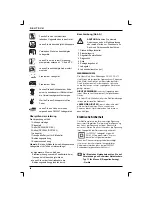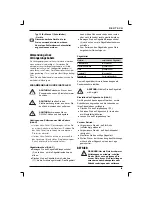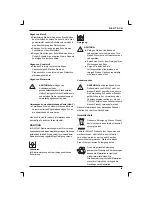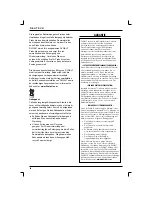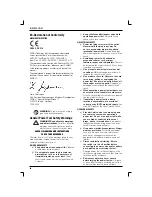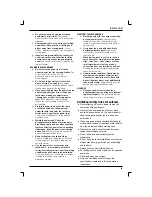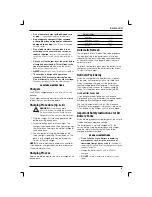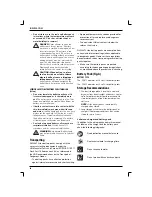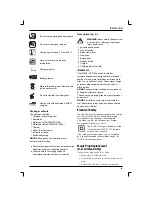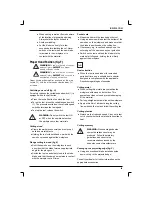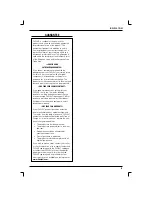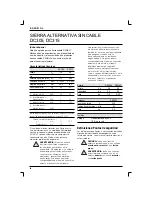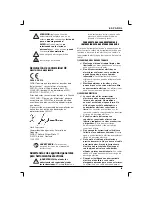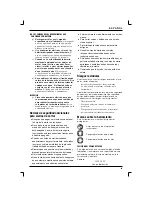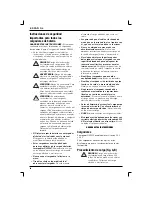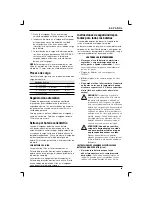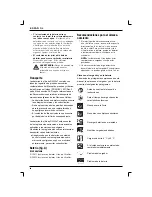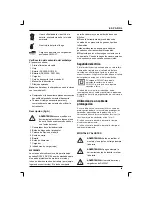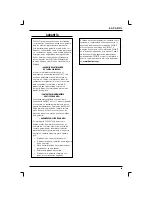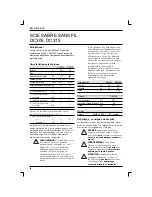
35
E N G L I S H
●
When sawing in walls or
fl
oors be aware
of the location of pipework and wiring.
Always hold the tool by its handle.
●
Avoid overloading.
●
Let the blade run freely for a few
seconds before starting the cut. Never
switch on the tool when the saw blade
is jammed in the workpiece or in
contact with the material.
Proper Hand Position (fi g. F)
WARNING:
To reduce the risk of serious
personal injury,
ALWAYS
use proper
hand position as shown.
WARNING:
To reduce the risk of serious
personal injury,
ALWAYS
hold securely in
anticipation of a sudden reaction.
Proper hand position requires one hand on the main
handle (13), with the other hand under the body (14)
as shown.
Switching on and off (
fi
g. A)
For safety reasons the variable speed switch (1) is
equipped with a lock-off button.
●
Press the lock-off button to unlock the tool.
●
To run the tool, press the variable speed switch
(1). The pressure exerted on the variable speed
switch determines the tool speed.
●
To stop the tool, release the switch.
WARNING:
Do not switch the tool ON
or OFF when the saw blade touches
the workpiece or other materials.
Cutting wood
●
Clamp the workpiece securely and remove all
nails and metal objects.
●
Holding the tool with both hands, work with the
saw shoe pressed against the workpiece.
Plunge cutting in wood (
fi
g. E)
●
Rest the saw shoe on the workpiece in such
a position that the blade forms an appropriate
angle for the plunge cut.
●
Switch the tool on and slowly feed in the blade.
Make sure that the saw shoe remains in contact
with the workpiece at all times.
Pocket cuts
●
Measure and mark the required pocket cut.
●
Using a narrow saw blade rest the bottom of the
saw shoe on the workpiece and make sure that
the blade is positioned on the cutting line.
●
If necessary, e.g. in con
fi
ned spaces, use the
outer edge of the saw shoe as your guideline.
●
Switch on the tool and feed the blade into the
material at full speed, holding the tool
fi
rmly
against the workpiece.
Dust extraction
●
When the tool is used indoor for extended
periods of time, use a suitable dust extractor
designed in compliance with the applicable
Directives regarding dust emission.
Cutting metal
●
When cutting thin metal always stabilize the
workpiece with wood on both sides. This
guarantees clean cuts and prevents damaging
of the material.
●
For long, straight cuts draw a line on the workpiece.
●
Apply a thin
fi
lm of lubricant along the cutting
line, switch on the tool and follow the cutting line.
Cutting plastics
●
Always work at reduced speed. Carry out a test
cut to check whether the material is sensitive to
heat.
Cutting masonry
WARNING:
When sawing asbestos
cement hazardous dust may be
produced. Follow the statutory
guidelines and observe the
recommendations issued by the
asbestos cement manufacturers.
Sawing up to a projecting edge (
fi
g. F)
●
Using a conventional blade installed upside
down, cut up to the projected edge.
Consult your dealer for further information on the
appropriate accessories.
Содержание DC305
Страница 1: ...DC305 DC315 www eu ...
Страница 3: ...1 A 5 6 7 8 1 2 3 4 5 ...
Страница 4: ...2 B C 3 11 3 11 3 11 3 11 D 4 12 ...
Страница 5: ...3 E F 13 14 ...


